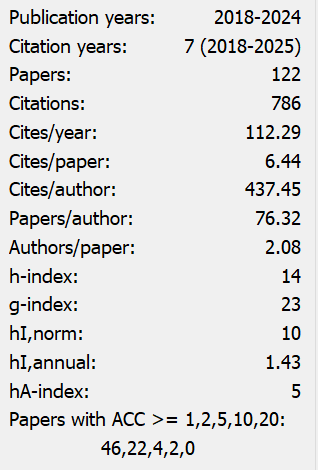Research on the Influence of Digital Finance Development on Entrepreneurial Engagement Among New Citizens
Abstract
The new citizen demographic constitutes a substantial and expanding segment of the urban workforce, playing a pivotal role in urban economic dynamics. Despite facing financing barriers during entrepreneurial ventures, this group has witnessed novel opportunities arising from the rapid evolution of digital finance. Utilizing data from the 2019 China Household Finance Survey (CHFS), this study examines the effect of digital finance development on entrepreneurial behavior among new citizens through empirical analysis via the Probit model. Results indicate that digital finance development significantly encourages entrepreneurial activity within this group, a finding robust to endogeneity controls and multiple robustness validations. Mechanistic analyse further demonstrates that this effect is mediated by the pathway: increased adoption of digital payment systems.
References
[2] Zhang, H., & Zhang, Y. (2023). Difficulties, causes and optimization strategies for precision financial services to meet the needs of new citizens. Jianghuai Tribune, (04), 79–89.
[3] Sun, B. (2016). Transaction costs, urban development and adjustment of housing system for new citizens. Journal of East China Normal University (Philosophy and Social Sciences Edition), 48(04), 55–61, 169.
[4] Stiglitz, J. E., & Weiss, A. (1981). Credit rationing in markets with imperfect information. The American Economic Review, 71(3), 393–410.
[5] Jiao, J., Huang, T., & Wang, T., et al. (2015). Empirical research on the development of inclusive finance in China. Shanghai Finance, (04), 12–22.
[6] Ni, Y., & Cheng, C. (2020). Comparative study on the impact of digital inclusive finance on welfare disparities between urban and rural citizens. Journal of Financial Development Research, (03), 49–57.
[7] Guo, F., Wang, J., & Wang, F., et al. (2020). Measuring China's digital financial inclusion development: Index compilation and spatial characteristics. China Economic Quarterly, 19(04), 1401–1418.
[8] Li, W., & Wu, Y. (2019). Housing provident fund, financial literacy and housing purchase-rental decisions of new citizens: Evidence from CHFS. Journal of Zhongnan University of Economics and Law, (04), 139–148.
[9] Xie, X., Shen, Y., & Zhang, H., et al. (2018). Can digital finance promote entrepreneurship? Evidence from China. China Economic Quarterly, 17(04), 1557–1580.
[10] Feng, Y., & Cai, J. (2021). Can digital inclusive finance promote entrepreneurship? Analysis based on provincial data and industrial structure heterogeneity. Contemporary Economic Science, 43(01), 79–90.
[11] Xie, C., & Li, H. (2024). Digital economy, entrepreneurial effects and urban-rural income disparity. Statistics & Decision, 40(19), 49–54.
[12] Xiong, J., & Dong, X. (2021). Does digital finance participation promote farmer entrepreneurship? Empirical analysis from financing scale and opportunity identification perspectives. Commercial Research, (05), 123–130.
[13] Huang, Q., Zhu, H., & Su, H. (2021). Impact of digital inclusive finance on farmer entrepreneurship choices. Fujian Tribune (The Humanities & Social Sciences Edition), (08), 85–102.
[14] Zhao, T., & Zhang, S. (2023). Digital finance, risk preference and farmer entrepreneurship behavior: Empirical analysis based on CHFS data. World Agriculture, (09), 110–122.
[15] Zou, W., & Zhang, X. (2024). Digital inclusive finance and floating population entrepreneurship: Empirical analysis based on CMDS data. Science and Technology Entrepreneurship Monthly, 37(01), 134–141.
[16] Wu, W., Gong, R., & Li, H. (2024). Digital inclusive finance and domestic migrant entrepreneurship. Studies of International Finance, (07), 15–25.
[17] Williamson, S. D. (1986). Costly monitoring, financial intermediation, and equilibrium credit rationing. Journal of Monetary Economics, 18(2), 159–179. https://doi.org/10.1016/0304-3932(86)90074-7
[18] Riding, A. L., & Haines Jr, G. (2001). Loan guarantees: Costs of default and benefits to small firms. Journal of Business Venturing, 16(6), 595–612. https://doi.org/10.1016/S0883-9026(00)00050-1
[19] Huang, H. (2018). Formation and challenges of the digital financial ecosystem: Experience from China. Economist, (04), 80–85.
[20] Zhang, X., Jiang, L., & Wang, S. (2023). Research on the entrepreneurial effect of digital inclusive finance. Economic Survey, 40(03), 139–149.
[21] Yin, Z., Gong, X., & Guo, P. (2019). Impact of mobile payment on entrepreneurship: Micro-evidence from China Household Finance Survey. China Industrial Economics, (03), 119–137.
[22] Zhou, Y., & Zhou, W. (2024). Impact of digital inclusive finance on farmer commercial credit supply. Nankai Economic Studies, (02), 83–99.
[23] Fu, Q., & Huang, Y. (2018). Heterogeneous impact of digital finance on rural financial demand: Evidence from China Household Finance Survey and Peking University Digital Financial Inclusion Index. Journal of Financial Research, (11), 68–84.
[24] Chen, X., & Xu, L. (2022). Digital finance, innovation and entrepreneurship, and income growth of urban-rural citizens. Journal of Agro-Forestry Economics and Management, 21(05), 537–546.

This work is licensed under a Creative Commons Attribution 4.0 International License.
Copyright for this article is retained by the author(s), with first publication rights granted to the journal.
This is an open-access article distributed under the terms and conditions of the Creative Commons Attribution license (http://creativecommons.org/licenses/by/4.0/).


























